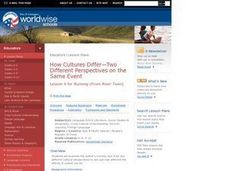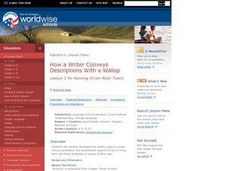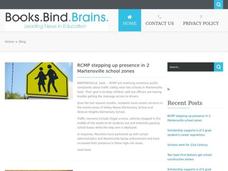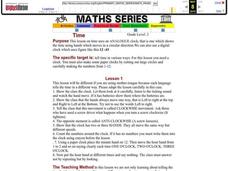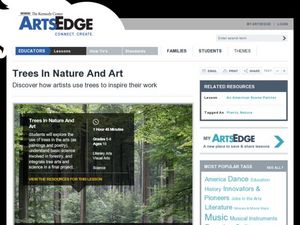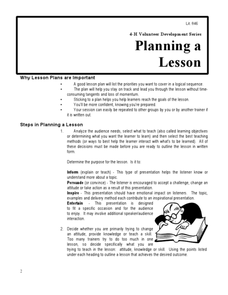Curated OER
How Cultures Differ-Two Different Perspectives on the Same Event
Students examine the author's running race from two different cultural perspectives to see just how different the effects of culture can be. They practice thinking about an issue from different perspectives and create a script that can...
Curated OER
How a Writer Conveys Descriptions With a Wallop
Students identify strategies the author used to vividly convey qualitative and quantitative aspects of life in China, then use those strategies in writing of their own. They examine the author's writing style and techniques to learn some...
Curated OER
Contributions
Students taste rice, one of the Nations first people's contributions. In this contributions lesson, students discover what rice looks like, feels like and tastes like. Students make recipes using wild rice.
Curated OER
Role Models
Students consider what makes a role model. In this positive qualities lesson, students read and discuss several books that have characters describing themselves in a positive manner. Students illustrate a self portrait, remembering to...
Curated OER
Aboriginal Quilting Activity
Students explore Aboriginal culture by participating in an art activity. In this First Nation history lesson, students utilize the Internet to research images and designs from Native American culture. Students create images on quilting...
Curated OER
Quilting
First graders investigate the color spectrum by painting their own pictures. In this artistic expression lesson, 1st graders discuss their own families and create ways to express their culture and family history on a picture quilt....
Curated OER
Contributions
Second graders examine the contributions of the First Nations. In this contributions lesson, 2nd graders discover the origin of popcorn. Students read about popcorn and how popcorn can be used in many ways. Students write a paragraph...
Curated OER
Governance
Second graders practice decision making. In this government lesson students role play making different types of decisions. They discuss how decisions affect life. The Great Binding Law of the Iroquois Confederacy is used as a focus.
Curated OER
Quilting
Second graders make a quilt. In this cultural diversity lesson plan, 2nd graders review their knowledge of the Metis people. Students work in groups to create a class quilt that illustrates the lives of these people. Quilt themes include...
Curated OER
Contributions - Grade 3
Third graders research and report on the contributions of the First Nations. In this First Nations contribution lesson, 3rd graders read and discuss books about the Metis, Inuit and other First Nations. They compare and contrast the...
Curated OER
Diversity: Origin Myths
Fifth graders analyze origin myths and the diversity of First Nations groups. In this history lesson, 5th graders review the geography of Canada and read various origin myths. Students illustrate one of the myths and research...
Curated OER
Contributions
Students explore the history of Canada by analyzing the First Nations' citizens. In this Native Canadian contributions instructional activity, students research the geography of Canada and create a book about the First Nations'...
Curated OER
Energetic Energy: A Child?s Guide to Responsible Energy Use
Students explore how energy transforms into heat. In this energy lesson students create models and find a need for fuel to make a Stirling engine.
Curated OER
Meeting the Needs of ELL Students in the Literature Classroom
ELL students can benefit when literature teachers use simple techniques to make lessons more accessible.
Curated OER
North, South, East, and West
A basic lesson on the teaching of the cardinal directions awaits your class. They are directed to go to different parts of the playground and where they attempt to describe their location in relation to each other by using the cardinal...
Curated OER
Time
Here, learners review telling time using an analog clock. They use a clock to tell time, make a paper clock, and discuss the concept of elapsed time. However, the lesson is not always easy to follow, nor are the questions clear.
Curated OER
Problem Posing Mathematics
Students work on multiplication problems. In this hands-on math lesson, students practice the concept of multiplication through manipulatives, arrays, pictures, and drawings. They discover other ways of learning multiplication besides...
Curated OER
Just the Facts, Jack
Third graders listen to music and discuss their responses to different styles separating their comments into facts and opinions. They evaluate a worksheet of statements by classifying the statements into fact and opinion.
Curated OER
Trees In Nature And Art
Young scholars study the use of trees in art. In this investigative lesson students create art using leaf rubbings and develop a classification method for trees.
Curated OER
4-H Volunteer Development Series - Planning a Lesson
Students examine the steps for effective lesson planning. In this lesson planning lesson plan, students look at how a lesson plan is developed to meet its audience purpose through effective delivery. They complete an associated worksheet.
Curated OER
Back to School
Students investigate the many ways of learning and examine classroom instructional techniques. They research the history of American Public Education.
Curated OER
Parenting in the Movies:Examining Responsibilities in Modern American Films
Students use films to identify the characteristics of a good parent. In groups, they research the different types of parenting methods used during colonial times, the Civil War and the Civil Rights movement. As a class, they develop...
Curated OER
Treaties Grade 11
Eleventh graders examine the First Nations Treaty. In this Canadian history lesson, 11th graders participate in talking circles that require them to compare "Human Rights," with the First Nations Treaty.
Curated OER
Treaties - Grade 12
Twelfth graders explore the history and current issues facing First Nations treaties. In this native studies lesson, 12th graders research modern land claims in Canada and write reports based on their findings.
